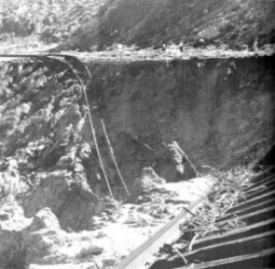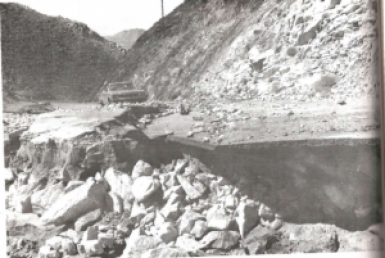 By Nadin Abbott
By Nadin Abbott
November 3, 2012 (San Diego) -- The East Coast has been battered by Hurricane Sandy, which caused dramatic damage. Many of us in sunny San Diego may believe our only major risks are earthquakes and wildfires. But our region is not immune to hurricanes. The first recorded major hurricane to hit San Diego County was 1858. Then in 1976, Hurricane Kathleen reduced I-8 to rubble, washed out a railway and destroyed a bridge in San Diego’s East County, causing major flooding as far east as Ocotillo in Imperial County. View photos of Hurricane Kathleen's damage from a book written by a CalTrans engineer.
Wikipedia lists several tropical storms and hurricanes that damaged Southern California and Arizona. Moreover, with climate change,storm tracks are slowly moving north from Mexico, so we are at increased risk. Regardless, you should be ready for a disaster. Government authorities have warned for years that people need to be ready to be on their own for 72 hours. This is a general civil defense recommendation not limited to the United States.
Speaking as a former disaster manager in another country, here are tips to prepare--in order of priority.
Food and water are top priorities.
Have enough food at hand, that needs no cooking, for three days. Here are a couple of lists for two people that do not require you to cook.
1.- Four cans of tuna, six energy bars, chips, one can opener.
2.- Two cans of wieners, crackers, two boxes, a large bottle of peanut butter, four nut bars ( to have some to spare)
3.- Two cans of cream of chicken soup, can be eaten cold, two cans of sardines, crackers, chips, and a two cans of beans
This is actually a little more than 72 hours, and it is far from luxurious, but will keep you fed.
It goes without saying, have some paper plates and disposable cutlery just in case you can’t wash your plates and utensils.
Alternatively you could go get a nice backpack that has all the essentials at the Home Depot. Realize, if you have food allergies those food rations might be problematic. Or you could get military-style meals ready to eat, or MREs. These are very much calorically dense, and again think about food allergies. If you have no issues like that. those backpacks are perfect to have in a vehicle at all times. Just remember the water in them is shelf stable for only five years. So do add a tag with the date and plan on changing these periodically.
Water: have six gallons at home. Whether you fill them at home before the storm hits, or have then store bought, you need a gallon per person per day, for drinking only. Remember, just like with the food, it needs to be cycled. My rule is, at the three month point, I use it to make coffee. Oh and since we live in quake country, you should have these at home anyway.
Also have a roll of paper towels, and three rolls of toilet paper. You should also consider feminine needs products, and if you have babies, or toddlers, extra diapers.
If you have babies, if you are a lactating woman, plan to drink more water than the gallon, and also have some formula and way to prepare it. This means extra water, and yes, clean bottles already for a few days.
If you have pets, be sure to include food, water, and food bowls for your animals, litter for cats, as well as crates to transport them if you have to evacuate. If you have larger animals, have a plan and check where the large animal shelters will be.
These are really minimum standards. Realize cycling your food is really easy. When you buy new cans, place them behind the old cans. That way you use older stock first. I am almost betting that most of you actually have the food, nothing luxurious, but you have some of this already. Going over your supplies every so often, like every six months, is not a bad idea either. Or if you prefer, after every major scare anywhere in the country.
Next Priority: radio
 I mentioned the can opener, let me add a multitool, a flashlight (invest in a good one, you will be glad you did) and a transistor radio. Ok, why the radio? In our world we are used to the internet. I can guarantee in a major disaster the net will go down, but the AM band will be on. In San Diego County the Emergency Station is KOGO 600. During the big blackout recently, even cell phone service was disrupted, so don’t count on your smart phone to work, either.
I mentioned the can opener, let me add a multitool, a flashlight (invest in a good one, you will be glad you did) and a transistor radio. Ok, why the radio? In our world we are used to the internet. I can guarantee in a major disaster the net will go down, but the AM band will be on. In San Diego County the Emergency Station is KOGO 600. During the big blackout recently, even cell phone service was disrupted, so don’t count on your smart phone to work, either.
There are many choices for that radio, ranging from cheap ones that you can get at $5 to $15 dollars that run on batteries,all the way to the hand cranked ones that can also charge your devices and have a weather band. If you can afford it, get one that can do that. If not, make sure you have that cheap radio and extra batteries. Trust me, in a disaster your main source of OFFICIAL information will come through that AM channel
We recently bought a solar charger for our devices. They can be found for about $20 and are worth the investment.
Now this is as bare bones of a list as it gets. And it is a good start. You are far from done, but it will help you to get started and to get in the habit of preparedness.
Other Things to Consider
Cash at hand: Try to have $40 per person at minimum, as an emergency reserve at home. Stores lose power and they will not take your credit card. Same with gas stations, if they have gasoline at all. Also make sure you have prescription medications and a spare pair of glasses. As to the medicines, either slowly work yourself to a month, or ask your doctor for an extra prescription.
Bleach, will disinfect your water, two drops for a gallon. Oh and that water tank behind your toilet, that is a reservoir of water that in a pinch can be used for washing (though not drinking), as long as you haven’t put toilet cleaning products in it. Better yet, before a storm approaches fill your tub with water that will be used to wash dishes, and other things. Do not confuse your drinking water with your washing water. If we have another blackout, fill containers as soon as possible with tap water.
Here is a check list of additional items to have on hand:
Dust mask
Sturdy gloves
Sturdy shoes
Garbage bags
Flashlights and batteries
Towelettes with disinfectant to clean hands
Whistle… it might sound crazy but especially in quake country, that whistle might allow rescuers to find you
A portable stove and fuel (use outdoors in a well ventilated area, and only if there is no broken or leaking gas main)
Fire starters (Yes fire is essential, in a survival situation so you can really move it to the top of the list, if you so wish however NEVER ignite a fire if you suspect a broken or leaking gas main, such as after an earthquake.)
A fire extinguisher--and learn how to use it. The worst time to learn how to one is when you need it.
There is more and here is the list from the County…
http://www.readysandiego.org/resources/checklist_1.pdf
Also, this is critical, make a plan. Have a contact OUTSIDE the area that all your family can call in case of an emergency. As crazy as it sounds sometimes you can call, or most likely text, to an outside area phone, but can’t get across the street. So having a contact outside can help.
This should also include a family reunification plan in case you get separated.
And one more thing. You have a smart phone? You have an IOS device? Please, make your way to the App Store for either and download the ready San Diego App. It will provide you, assuming the web is up, or the cell phone towers, with the information you need directly from emergency services. It is an RSS feed on the go. It also has these preparation lists on it, so you can go ahead and check them as you go. I also included the most essential parts of that preparedness list.
Some things that you would find useful, but not necessarily critical, include a good camping tent, sleeping bags, blankets, and good tools like an entrenching tool, and paracord. They are not in most lists for a reason. Another, especially if you live in the back country, like many of our readers do, generators and fuel to go with them.
You have children? Trust me, some board games will be a lifesaver.
Add a good book to your list of things to have in your kit, and a deck of cards. It will keep you entertained. Oh and remember, check on your neighbors after the incident. Believe it or not, during the black out I loaned out radios to my neighbors. Yes, you read right, we have a few transistor radios.
One last thing, if we do have a major disaster, have patience. Response can seem to be slow to you, but remember, this is a large county. It will take time. This is one reason you are told, be ready to be on your own for 72 hours.
Oh and this is in no manual, but mother taught me this trick and I have found it invaluable over the decades. Always fuel up when you reach half a tank. That way you will have fuel to evacuate whenever a disaster strikes.











Recent comments